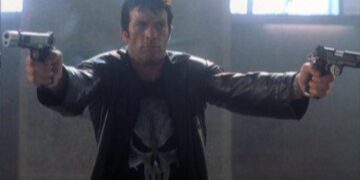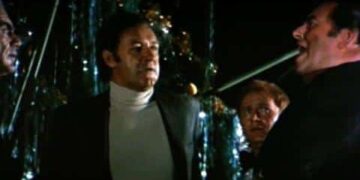Batman: The Killing Joke is a graphic novel written by the legendary Alan Moore and illustrated by Brian Bolland.
Published in 1988, it is considered one of the most iconic and influential Batman stories of all time. The novel explores the complex relationship between Batman and his arch-nemesis, the Joker, providing a deep dive into the Joker’s twisted psyche.
In 2016, the story was adapted into an animated movie directed by Sam Liu and featuring the voices of Kevin Conroy as Batman and Mark Hamill as the Joker.
The film, like its source material, received critical acclaim and has become a fan favorite.
This article serves as an essential guide for fans, providing a graphic novel summary, movie summary, intriguing differences between the two mediums, and much more.
Graphic novel summary and background
The Killing Joke graphic novel begins with Batman visiting the Joker in Arkham Asylum, only to discover that the villain has escaped and replaced himself with a decoy.
The story then delves into the Joker’s past, showing him as a failed comedian struggling to support his pregnant wife. Desperate for money, he agrees to assist a gang of criminals in a robbery, which ultimately leads to his transformation into the Joker.
The present-day storyline follows the Joker as he kidnaps Commissioner Gordon, subjects him to physical and psychological torture, and shoots his daughter, Barbara Gordon, paralyzing her.
Batman ultimately confronts the Joker and saves the Commissioner.
The story ends with a cryptic scene in which Batman may or may not have killed the Joker, leaving readers to ponder the outcome.
Movie summary and adaptation
The animated movie adaptation of Batman: The Killing Joke follows the same core plot as the graphic novel, but with some notable additions and alterations.
The film begins with an extended prologue focusing on the relationship between Batman and Batgirl (Barbara Gordon), which was not present in the original story.
In the movie, the Joker’s escape and subsequent actions mirror those from the graphic novel, with the kidnapping and torture of Commissioner Gordon and the shooting of Barbara Gordon.
Batman’s pursuit of the Joker and their final confrontation also remain faithful to the source material.
However, the ambiguous ending of the graphic novel is replaced with a more definitive conclusion in the film.
Intriguing differences between the graphic novel and movie
There are several key differences between the Killing Joke graphic novel and its animated adaptation.
The most notable is the addition of the Batgirl subplot, which was not part of the original story. This new storyline explores the character’s motivations and her complex relationship with Batman, ultimately leading to her retirement as Batgirl.
Another difference is the alteration of the Joker’s origin story: in the graphic novel, the Joker’s transformation is portrayed as a tragic accident, whereas, in the movie, the character deliberately jumps into the vat of chemicals to escape Batman.
This change makes the Joker’s transformation seem more intentional, adding a layer of darkness to the character.
Finally, the ambiguous ending of the graphic novel is replaced with a more definitive conclusion in the movie.
While this change provides closure for viewers, it also removes some of the mystery that made the original story so compelling.
Parent guide for Batman: The Killing Joke
While Batman: The Killing Joke is an iconic and influential Batman story, it is important for parents to be aware that the content may not be suitable for younger audiences.
The graphic novel and movie both contain dark themes, intense violence, and psychological torture, which may be disturbing for some readers and viewers.
Parents should exercise caution when allowing their children to engage with this material, as the story explores the darker aspects of the Batman universe.
It is recommended that Batman: The Killing Joke be reserved for mature audiences who can appreciate and understand the complex themes presented within the story.
When and where does Batman: The Killing Joke take place?
The events of Batman: The Killing Joke take place in Gotham City, the fictional metropolis that serves as the home to Batman and his allies.
The graphic novel and movie do not provide a specific timeframe for the story, but it is widely accepted that the events occur during Batman’s prime crime-fighting years.
The story primarily unfolds in Arkham Asylum, the Joker’s hideout, and various locations throughout Gotham City as Batman pursues his nemesis.
The Joker’s origin story, presented through flashbacks, takes place in a rundown amusement park and a chemical plant.
A guide to the characters: Who’s who in Batman: The Killing Joke
- Batman/Bruce Wayne: The Caped Crusader and protector of Gotham City, Batman is driven by a sense of justice and a personal vendetta against crime. In The Killing Joke, he seeks to apprehend the Joker and rescue Commissioner Gordon.
- The Joker: Batman’s arch-nemesis, the Joker is a psychopathic criminal with a twisted sense of humor and a penchant for chaos. His past and true identity are shrouded in mystery, but The Killing Joke provides a possible origin story for the character.
- Commissioner James Gordon: The Commissioner of the Gotham City Police Department, Gordon is a close ally of Batman and a dedicated public servant. In The Killing Joke, he is kidnapped by the Joker and subjected to unspeakable torture.
- Barbara Gordon/Batgirl: The daughter of Commissioner Gordon, Barbara is a skilled crimefighter who operates as Batgirl alongside Batman. She is a central figure in the film adaptation of The Killing Joke, with her relationship with Batman explored in greater detail than in the graphic novel.
- The Joker’s Wife: In the Joker’s origin story, his wife is a pregnant woman who supports her husband’s aspirations to become a comedian. Her tragic death serves as a catalyst for the Joker’s descent into madness.
Memorable quotes from Batman: The Killing Joke
Some of the most memorable quotes from Batman: The Killing Joke showcase the story’s exploration of the relationship between Batman and the Joker, as well as the Joker’s twisted worldview.
These are some of the best:
- “All it takes is one bad day to reduce the sanest man alive to lunacy.” – The Joker
- “I’ve demonstrated there’s no difference between me and everyone else! All it takes is one bad day to reduce the sanest man alive to lunacy.” – The Joker
- “I don’t want to hurt you. I don’t want either of us to end up killing the other. But we’re running out of alternatives… and we both know it.” – Batman
The soundtrack by Kristopher Carter and Lolita Ritmanis
The soundtrack for Batman: The Killing Joke was composed by Kristopher Carter and Lolita Ritmanis, two accomplished composers known for their work on various animated superhero projects. The score captures the dark and moody atmosphere of the story, incorporating elements of suspense, action, and emotion.
Notable tracks from the soundtrack include “The Killing Joke Main Title,” “I Go Looney,” and “The Last Laugh.”
The music enhances the viewing experience, providing a fitting backdrop for the intense and dramatic events that unfold onscreen.
Curiosities and trivia surrounding Batman: The Killing Joke
Batman: The Killing Joke is a story that has captivated fans for decades, and as such, there are numerous curiosities and pieces of trivia surrounding the graphic novel and movie.
Here are a few interesting facts:
- The story was originally intended to be a standalone, but DC Comics decided to incorporate it into the Batman canon after it was completed.
- The graphic novel was initially met with mixed reviews upon its release, with some critics praising its exploration of the Joker’s psyche and others critiquing its portrayal of violence against women.
- The movie was initially given an R rating due to its intense violence, but it was later edited to receive a PG-13 rating.
- Mark Hamill, who voices the Joker in the movie, has stated that The Killing Joke is his favorite Joker story and that he was thrilled to be a part of the adaptation.
- The Killing Joke has been adapted into various other media, including a video game and a one-act play.
Tips for cosplay and dressing like characters from Batman: The Killing Joke
For fans who wish to dress up as characters from Batman: The Killing Joke, there are plenty of costume options available.
Here are a few tips for cosplayers:
- Batman: To dress like the Dark Knight, you’ll need a black bodysuit, cape, and cowl. You can add the signature bat symbol to your chest using fabric paint or a stencil. Don’t forget to accessorize with a utility belt and grappling hook.
- The Joker: The Joker’s outfit is a bit more complex, but it can be easily recreated with a purple suit, green vest, and orange shirt. Add a green bowtie and white gloves to complete the look. For makeup, use white face paint, dark eyeliner, and red lipstick to create the Joker’s iconic grin.
- Batgirl: Batgirl’s costume consists of a black bodysuit, yellow boots, and a yellow utility belt. The cape and cowl can be made from black fabric, and the bat symbol can be added using fabric paint or a stencil.
Alan Moore bio and works: The mind behind Batman: The Killing Joke
Alan Moore is one of the most celebrated and controversial comic book writers of all time, with a career spanning several decades.
He is known for his dark and complex storytelling, as well as his critiques of mainstream superhero comics.
In addition to Batman: The Killing Joke, Moore is responsible for several other iconic graphic novels, including Watchmen, V for Vendetta, and From Hell.
He has won numerous awards for his work and is considered a major influence on the comic book medium.
Ending explained: Unraveling the mystery of Batman: The Killing Joke
The ambiguous ending of Batman: The Killing Joke has been the subject of much debate and speculation among fans.
Some believe that Batman kills the Joker at the end of the story, while others think that the Joker’s fate is left intentionally ambiguous.
In an interview, Alan Moore stated that he intended the ending to be open to interpretation, leaving readers to decide for themselves what happened.
The film adaptation, however, provides a more definitive ending, with Batman apprehending the Joker and taking him back to Arkham Asylum.
Remake, sequel, and spin-off possibilities
While there are no current plans for a remake, sequel, or spin-off of Batman: The Killing Joke, the story’s enduring popularity has led to speculation about future adaptations.
Some fans have suggested that a live-action movie or television series could be in the works, while others believe that a sequel or spin-off featuring Batgirl could be a possibility.
Other media by Sam Liu: Exploring the director’s repertoire
Sam Liu is a prolific director of animated superhero movies and has worked on several other DC Comics adaptations.
Here are a few notable examples:
- Superman/Batman: Public Enemies
- Justice League: Crisis on Two Earths
- All-Star Superman
- Justice League: Gods and Monsters
Similar media to Batman: The Killing Joke: Recommendations for fans
For fans who enjoyed Batman: The Killing Joke, there are plenty of other graphic novels, movies, and TV shows that explore similar themes and characters.
Here are a few recommendations:
- Watchmen by Alan Moore
- The Dark Knight Returns by Frank Miller
- Batman: Year One by Frank Miller
- Joker (2019) directed by Todd Phillips
- Gotham (TV series)
- Daredevil (TV series)
Essential book club questions for Batman: The Killing Joke
For book clubs or discussion groups looking to delve deeper into the themes and ideas presented in Batman: The Killing Joke, here are a few essential questions to consider:
- What is the role of violence in the story, and how does it reflect the characters’ motivations and worldviews?
- How does the Joker’s backstory shape our understanding of the character, and what does it reveal about his relationship with Batman?
- What is the significance of the ending, and how does it affect our perceptions of the story as a whole?
- How does the Batgirl subplot add to the story, and what does it tell us about the character’s relationship with Batman?
- What is the overall message of Batman: The Killing Joke, and how does it relate to larger themes in the Batman universe?
Video games inspired by Batman: The Killing Joke
Batman: The Killing Joke has been adapted into several video games over the years, including:
- Batman: Arkham Origins
- Batman: The Telltale Series
- Batman: The Enemy Within
These games incorporate elements from the graphic novel and provide players with the opportunity to explore the story in a new and interactive way.
Travel guide: Visiting Batman: The Killing Joke locations
While the events of Batman: The Killing Joke take place in a fictional city, there are several real-world locations that served as inspiration for the story.
Here are a few places to visit for fans looking to immerse themselves in the world of Batman:
- The Joker’s amusement park: The Joker’s hideout in the graphic novel is based on the abandoned amusement park at the end of Pier 39 in San Francisco. While the park has since been demolished, fans can still visit the location and imagine the park’s twisted attractions.
- The chemical plant: The chemical plant where the Joker is transformed is based on the Dupont Chemical Plant in Wilmington, Delaware. While the plant is not open to the public, fans can still visit the nearby Dupont Environmental Education Center to learn more about the area’s industrial history.
- Gotham City: While Gotham City is a fictional location, fans can still visit various real-world cities that inspired the setting, including New York City, Chicago, and Detroit.
Conclusion: The lasting impact of Batman: The Killing Joke
Batman: The Killing Joke is a story that has endured for decades, captivating audiences with its exploration of the complex relationship between Batman and the Joker.
The graphic novel and movie have left an indelible mark on the Batman franchise, inspiring countless adaptations and imitations.
For fans of the Dark Knight, Batman: The Killing Joke is an essential read and watch, providing a deep dive into the psyche of one of the most iconic villains in comic book history.













